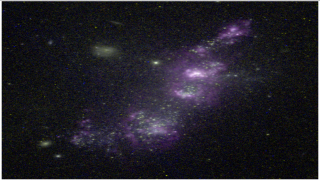Bibcode
Lagos, Patricio; Telles, Eduardo; Muñoz-Tuñón, Casiana; Carrasco, Eleazar R.; Cuisinier, François; Tenorio-Tagle, Guillermo
Referencia bibliográfica
The Astronomical Journal, Volume 137, Issue 6, pp. 5068-5079 (2009).
Fecha de publicación:
6
2009
Número de citas
37
Número de citas referidas
32
Descripción
We present Integral Field Unit GMOS-IFU data of the compact H II galaxy
UM 408, obtained at the Gemini South telescope, in order to derive the
spatial distribution of emission lines and line ratios, kinematics,
plasma parameters, and oxygen abundances as well the integrated
properties over an area of 3''×4farcs4 equivalent with ~750 pc
× 1100 pc located in the central part of the galaxy. The starburst
in this area is resolved into two giant regions of about 1farcs5 and 1''
(~375 and ~250 pc) diameter, respectively and separated 1.5-2'' (~500
pc). The extinction distribution concentrate its highest values close
but not coincident with the maxima of Hα emission around each one
of the detected regions. This indicates that the dust has been displaced
from the exciting clusters by the action of their stellar winds. The
ages of these two regions, estimated using Hβ equivalent widths,
suggest that they are coeval events of ~5 Myr with stellar masses of
~104 M sun. We have also used [O III]/Hβ and
[S II]/Hα ratio maps to explore the excitation mechanisms in this
galaxy. Comparing the data points with theoretical diagnostic models, we
found that all of them are consistent with excitation by photoionization
by massive stars. The Hα emission line was used to measure the
radial velocity and velocity dispersion. The heliocentric radial
velocity shows an apparent systemic motion where the east part of the
galaxy is blueshifted, while the west part is redshifted, with a
relative motion of ~10 km s-1. The velocity dispersion map
shows supersonic values typical for extragalactic H II regions. We
derived an integrated oxygen abundance of 12+log(O/H) = 7.87 summing
over all spaxels in our field of view. An average value of 12+log(O/H) =
7.77 and a difference of Δ(O/H) = 0.47 between the minimum and
maximum values (7.58 ± 0.06-8.05 ± 0.04) were found,
considering all data points where the oxygen abundance was measured. The
spatial distribution of oxygen abundance does not show any significant
gradient across the galaxy. On the other hand, the bulk of data points
are lying in a region of ±2σ dispersion (with σ = 0.1
dex) around the average value, confirming that this compact H II galaxy,
like other previously studied dwarf irregular galaxies, is chemically
homogeneous. Therefore, the new metals processed and injected by the
current star formation episode are possibly not observed and reside in
the hot gas phase, whereas the metals from previous events are well
mixed and homogeneously distributed through the whole extent of the
galaxy.
Proyectos relacionados

Grupo de Estudios de Formación Estelar GEFE
El proyecto interno GEFE está enmarcado en el proyecto coordinado, ESTALLIDOS, financiado por el plan nacional desde el año 2001. El ultimo proyecto aprobado es ESTALLIDOS 6.0 (AYA2016- 79724-C4-2-P). En el proyecto GEFE trabajamos en base al caso científico del proyecto ESTALLIDOS 6.0. Los estallidos de formación estelar (Starbursts o SB) son
Casiana
Muñoz Tuñón